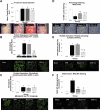Reversal of anemia with allogenic RBC transfusion prevents post-cardiopulmonary bypass acute kidney injury in swine
- PMID: 21653630
- PMCID: PMC3174544
- DOI: 10.1152/ajprenal.00145.2011
Reversal of anemia with allogenic RBC transfusion prevents post-cardiopulmonary bypass acute kidney injury in swine
Abstract
Anemia during cardiopulmonary bypass (CPB) is strongly associated with acute kidney injury in clinical studies; however, reversal of anemia with red blood cell (RBC) transfusions is associated with further renal injury. To understand this paradox, we evaluated the effects of reversal of anemia during CPB with allogenic RBC transfusion in a novel large-animal model of post-cardiac surgery acute kidney injury with significant homology to that observed in cardiac surgery patients. Adult pigs undergoing general anesthesia were allocated to a Sham procedure, CPB alone, Sham+RBC transfusion, or CPB+RBC transfusion, with recovery and reassessment at 24 h. CPB was associated with dilutional anemia and caused acute kidney injury in swine characterized by renal endothelial dysfunction, loss of nitric oxide (NO) bioavailability, vasoconstriction, medullary hypoxia, cortical ATP depletion, glomerular sequestration of activated platelets and inflammatory cells, and proximal tubule epithelial cell stress. RBC transfusion in the absence of CPB also resulted in renal injury. This was characterized by endothelial injury, microvascular endothelial dysfunction, platelet activation, and equivalent cortical tubular epithelial phenotypic changes to those observed in CPB pigs, but occurred in the absence of severe intrarenal vasoconstriction, ATP depletion, or reductions in creatinine clearance. In contrast, reversal of anemia during CPB with RBC transfusion prevented the reductions in creatinine clearance, loss of NO bioavailability, platelet activation, inflammation, and epithelial cell injury attributable to CPB although it did not prevent the development of significant intrarenal vasoconstriction and endothelial dysfunction. In conclusion, contrary to the findings of observational studies in cardiac surgery, RBC transfusion during CPB protects pigs against acute kidney injury. Our study underlines the need for translational research into indications for transfusion and prevention strategies for acute kidney injury.
Figures



References
-
- Ascione R, Lloyd CT, Underwood MJ, Gomes WJ, Angelini GD. On-pump versus off-pump coronary revascularization: evaluation of renal function. Ann Thorac Surg 68: 493–498, 1999 - PubMed
-
- Casutt M, Seifert B, Pasch T, Schmid ER, Turina MI, Spahn DR. Factors influencing the individual effects of blood transfusions on oxygen delivery and oxygen consumption. Crit Care Med 27: 2194–2200, 1999 - PubMed
-
- Council of Europe Guide to the Preparation, Use and Quality Control of Blood Components (12th ed.) Strasbourg: Council of Europe Publishing, 2006
-
- Coward RJ, Welsh GI, Yang J, Tasman C, Lennon R, Koziell A, Satchell S, Holman GD, Kerjaschki D, Tavaré JM, Mathieson PW, Saleem MA. The human glomerular podocyte is a novel target for insulin action. Diabetes 54: 3095–3102, 2005 - PubMed
-
- Habib RH, Zacharias A, Schwann TA, Riordan CJ, Engoren M, Durham SJ, Shah A. Role of hemodilutional anemia and transfusion during cardiopulmonary bypass in renal injury after coronary revascularization: implications on operative outcome. Crit Care Med 33: 1749–1756, 2005 - PubMed
Publication types
MeSH terms
Substances
Grants and funding
LinkOut - more resources
Full Text Sources
Medical

